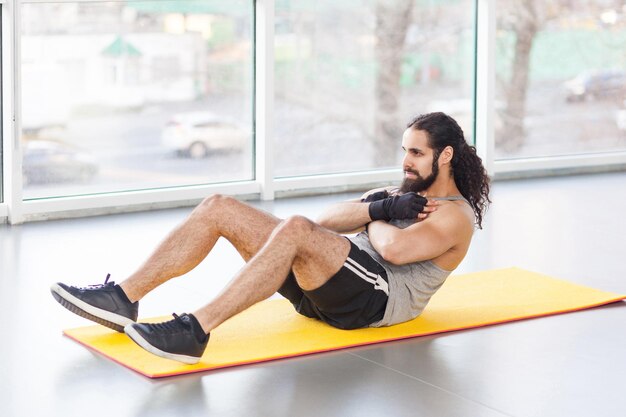When I first embarked on my fitness journey, I quickly discovered that cardio exercises for men were the unsung heroes of transformation. It’s astonishing how these dynamic movements not only sculp your body but also propel you towards your fitness goals, weight loss, and overall well-being. Cardio isn’t just about breaking a sweat; it’s a powerful catalyst that ignites your metabolism and enhances your endurance. With each heartbeat, I realized I was building a healthier heart and a stronger determination. Trust me, incorporating cardio into your routine can unlock a world of benefits that go far beyond mere appearance.
Whether you’re a fitness novice or a seasoned gym-goer, the key to achieving your desired physique lies in understanding the immense potential of these exercises. Cardio can improve your mood, boost your energy levels, and aid in recovery, making it an indispensable part of any fitness regimen. It’s time to embrace these workouts, as they not only challenge your body but also sharpen your mind. Join me in exploring how we can harness the power of cardio exercises for men, and watch as we transform our lives together!
Understanding Cardio and Its Benefits
Top Cardio Exercises for Men
Top Cardio Exercises for Men
When it comes to enhancing cardiovascular health, several exercises stand out for their efficiency and effectiveness. One of the foremost options is running, a straightforward yet powerful cardio workout. It not only burns calories but also boosts mood and endurance. Aim for at least 30 minutes, 3-5 times a week, while gradually increasing speed and distance.
Cycling is another excellent choice, whether on a stationary bike or outdoors. It encourages lower body strength and cardiovascular fitness while being low-impact, making it suitable for all fitness levels. Incorporate cycling into your routine for 45 minutes to an hour for optimal results.
Jump rope might surprise some, but it proves to be a fun and intensive cardio workout. In just 15-20 minutes, you can elevate your heart rate, strengthen your legs, and improve coordination. It’s a cost-effective exercise that can be done almost anywhere, whether indoors or outdoors.
High-Intensity Interval Training (HIIT) is gaining momentum for its time-efficient structure that yields significant benefits. Sessions range from 15 to 30 minutes, alternating short bursts of intense activity with rest periods. This form of exercise enhances metabolism and allows for greater calorie burn in less time.
Lastly, swimming offers a comprehensive workout that engages multiple muscle groups while providing a refreshing way to build endurance. Aim for continuous laps over 30 minutes to maximize its cardiovascular benefits while also ensuring full recovery between sessions.
How to Create a Cardio Workout Plan

Creating a personalized cardio workout plan is essential for men aiming to enhance their fitness. First, assess your current fitness level. This step helps to identify which intensity and duration are suitable for your routines. For beginners, starting with 20 minutes of moderate activity is effective, while more advanced individuals may consider 45 to 60 minutes of vigorous exercise.
Additional Resources for Your Cardio Workout Journey
Enhance your fitness knowledge and experience with these valuable resources.
- ACE Exercise Library – Explore a comprehensive collection of exercises and workout tips tailored for various fitness levels.
- MyFitnessPal – An app to track workouts, food intake, and monitor progress effortlessly.
- Runner’s World – A resource for running guides, training plans, and expert advice for runners of all levels.
- CDC Physical Activity Guidelines – Official recommendations for physical activity to help you create balanced fitness routines.
- Nike Training Club – Access a variety of effective workout plans and fitness tips directly from professionals.
Next, choose a variety of cardio exercises for men. Options include running, cycling, swimming, or high-intensity interval training (HIIT). Mixing these activities not only keeps workouts engaging but also targets different muscle groups, maximizing benefits.
Determine the frequency of your workouts. Aim for at least 150 minutes of moderate-intensity cardio each week, broken down into manageable sessions. Establish a schedule that fits into your lifestyle, ensuring consistency while allowing for rest and recovery days.
Finally, track your progress. Utilize fitness apps or journals to log your workouts, noting duration, intensity, and any improvements. Monitoring progress not only boosts motivation but also enables you to adjust your plan as needed, ensuring you continue to challenge yourself and achieve your fitness goals.
Nutrition Tips to Complement Cardio
Hydration is equally important; water maintains optimal performance and prevents fatigue, allowing men to push through longer workouts. Incorporating healthy fats from sources like avocados and nuts can provide additional energy needed for prolonged exercises. Additionally, timing meals strategically, with a focus on pre and post-workout nutrition, ensures that the body is equipped with the necessary nutrients to maximize performance and recovery, ultimately leading to more effective cardio sessions.
Common Mistakes to Avoid
Another frequent misstep is performing cardio at the same intensity every session. Over time, the body adapts, and progress stalls. Mixing up the intensity with interval training can optimize fat burning and increase cardiovascular endurance. Incorporate short bursts of high-intensity activity followed by recovery periods to keep your body challenged.
Furthermore, some men focus primarily on cardio while neglecting strength training. While cardio is vital for heart health, muscle-building workouts enhance overall metabolism and support weight loss. Balance your routine by integrating strength workouts two to three times a week to boost results.
Lastly, hydration is often overlooked. Dehydration can significantly impair performance and recovery. Ensure adequate fluid intake before, during, and after workouts. Carry a water bottle during sessions to maintain hydration levels and enhance endurance. By avoiding these common mistakes, you can maximize the benefits of your cardio exercises and transform your body effectively.
Frequently Asked Questions
-
What are the best warm-up exercises before cardio?
Dynamic stretches like leg swings, arm circles, and light jogging are effective warm-up exercises. Aim for five to ten minutes to increase your heart rate and prepare your muscles.
-
How can I effectively incorporate interval training into my routine?
Start by alternating short bursts of high-intensity activity (like sprinting) with recovery periods (like walking) for 20-30 minutes, adjusting the intensity and duration according to your fitness level.
-
What type of strength training should I include in my cardio routine?
Incorporate compound movements such as squats, deadlifts, bench presses, and pull-ups two to three times a week. Focus on major muscle groups to improve overall strength and support your cardio efforts.
-
How do I know if I’m properly hydrated during workouts?
Check your urine color; pale yellow indicates good hydration. Also, aim to drink water regularly before, during, and after exercise to maintain optimal hydration levels.
-
What are the warning signs of dehydration during exercise?
Signs of dehydration include excessive thirst, dry mouth, fatigue, dizziness, and dark-colored urine. Pay attention to these signals and drink fluids accordingly.





